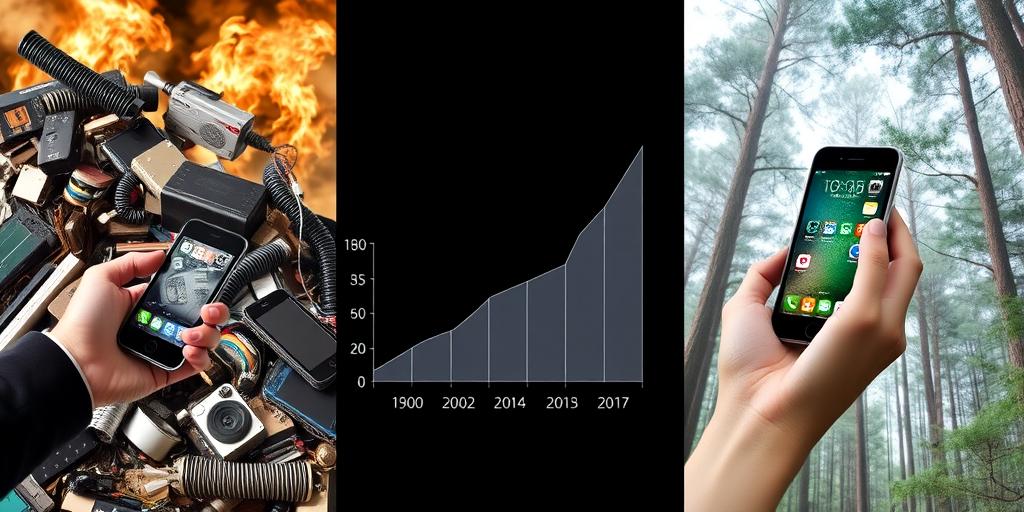We live in a world increasingly dominated by gadgets. From smartphones and laptops to smartwatches and smart home devices, technology has become an integral part of our lives. But as our dependence on gadgets grows, so too does the Gadget Impact on the environment. The rapid production and consumption of electronic devices have far-reaching consequences for our planet, raising concerns about resource depletion, pollution, and climate change. It’s time to take a closer look at the environmental impact of gadgets and explore how we can navigate this complex relationship responsibly.
The Environmental Impact of Gadgets
Gadgets are not inherently evil, but their production and use come with significant environmental costs. Let’s break down the key areas of concern:
Resource Extraction and Manufacturing
The raw materials used to make gadgets, such as precious metals, rare earth elements, and plastics, are extracted from the earth. This process often involves mining and drilling, which can have devastating impacts on ecosystems and communities. Deforestation, water contamination, and soil erosion are just some of the consequences of resource extraction. Furthermore, the manufacturing of gadgets requires massive amounts of energy and water, contributing to greenhouse gas emissions and depletion of natural resources.
Energy Consumption and Carbon Footprint
Gadgets are energy-hungry devices. From powering our smartphones to charging our laptops, our reliance on electronics contributes significantly to global energy consumption. This energy often comes from fossil fuels, leading to a substantial carbon footprint. Data centers that power our online services and cloud storage also consume massive amounts of energy, further adding to the environmental burden.
E-Waste and Recycling Challenges
The lifespan of gadgets is often short, leading to a growing mountain of electronic waste (e-waste). This discarded technology contains hazardous materials that can contaminate the environment if not disposed of properly. Recycling e-waste is a complex process, and much of it ends up in landfills or is illegally exported to developing countries, where it poses serious health and environmental risks.
The Role of Consumer Behavior
While the production and disposal of gadgets have a major impact, consumer behavior plays a crucial role in shaping the environmental footprint of our technology.
Planned Obsolescence and Upgrade Cycles
The design and marketing of gadgets often involve planned obsolescence, making devices intentionally outdated or difficult to repair. This encourages consumers to upgrade frequently, contributing to the cycle of production, consumption, and disposal.
The Desire for the Latest Technology
The constant release of new and improved gadgets fuels a culture of consumerism, driving demand for the latest technology. This “upgrade mentality” often leads to the unnecessary disposal of perfectly functional devices.
Sustainable Consumption Practices
Fortunately, consumers can make conscious choices to reduce their environmental impact. Choosing durable, repairable gadgets, delaying upgrades, and opting for refurbished devices are some steps towards sustainable consumption. Additionally, learning about the environmental impacts of different brands and products can empower informed purchasing decisions.
Solutions and Innovations
Addressing the environmental impact of gadgets requires a multifaceted approach involving both technological innovations and societal shifts.
Eco-Friendly Design and Manufacturing
Developing gadgets with eco-friendly materials, energy-efficient components, and recyclable designs can minimize their environmental footprint. Companies are increasingly focusing on sustainable practices, using recycled materials, reducing toxic substances, and implementing circular economy principles.
Extended Product Lifecycles and Repair
Encouraging extended product lifecycles through improved durability, repairability, and modular design can reduce the need for constant replacements. Promoting repair services and providing readily available spare parts can also help extend the life of gadgets and decrease e-waste.
Responsible Recycling and E-Waste Management
Investing in efficient and responsible e-waste management systems is crucial. This includes developing better recycling technologies, creating incentives for responsible disposal, and holding companies accountable for the environmental impact of their products.
Individual Responsibility and Collective Action
As consumers, we have a responsibility to be mindful of our technology choices and engage in sustainable practices. This includes opting for eco-friendly gadgets, extending the lifespan of our devices, and supporting companies committed to environmental responsibility. Collective action, through advocacy, consumer pressure, and policy changes, can further encourage sustainable practices within the technology industry.
The Future of Sustainable Technology
The future of technology holds immense potential for a more sustainable future. Innovations in materials science, energy efficiency, and circular economy principles are paving the way for a new generation of eco-friendly gadgets. By embracing sustainable practices and demanding responsible solutions, we can ensure that technology serves humanity without compromising the health of our planet.




